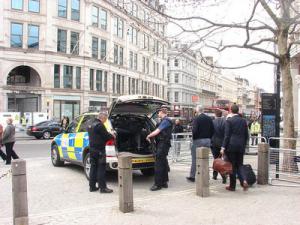TerrorismU.K. arrests record number of terrorism suspects, especially women, teenagers
According to the U.K. Home Office quarterly bulletin, 315 terror suspects – a record — have been arrested in the United Kingdom in the past year, with a sharp increases in arrests of women and teenagers. Therise in the number of terrorism-related suspects arrested is a reflection of the determined effort by the police and security services to address the ISIS threat and stem the flow of Britons to, and from, Syria.

City of London police unloading weapons // Source: commons.wikimedia.org
According to the U.K. Home Office quarterly bulletin, 315 terror suspects – a record — have been arrested in the United Kingdom in the past year, with a sharp increases in arrests of women and teenagers.
In the twelve months to September, the number of women arrested for terrorism-related offenses more than doubled, from 21 to 50. The number of under-18s detained was 15 – the highest ever level.
The Daily Mail reports that the 31 percent rise in the number of terrorism-related suspects arrested is a reflection of the determined effort by the police and security services to address the ISIS threat and stem the flow of Britons to, and from, Syria.
The Home Office notes that women now account for 16 percent of all terrorism-related arrests. The bulletin highlights that fact that normally women or girls make up only 8 percent of those arrested, and that one in five of all arrests of female terror suspects in Britain since the 9/11 attacks fourteen years ago have happened in the last year.
“The majority of the increase in the number of women getting arrested has been linked to international-related terrorism,” the Home Office bulletin said.
The detailed figures offered in the report show that the increased number of those arrested for terrorism-related offenses included a 41 percent increase in those who considered themselves Asian and a 25 percent increase in those who considered themselves white. The proportion of terror suspects who are British has risen to 79 percent of those arrested this year, compared with 56 percent in 2001, when the statistics were first collected.
The Home Office figures for the twelve months to September 2015 show that nearly 40 percent (124) of those arrested have been charged; 22 percent (68) were released on bail; and 37 percent (115) were released without charge.
The 37 percent of those arrested then released without charge is an increase over the previous year’s 31 percent, but below the 53 percent who were arrested then released in 2013.
The Home Office said that the 31 percent increase in the number of terrorism-related suspects arrested was driven by a large number of arrests in two quarters: October to December 2014 and April to June 2015. “The most recent quarter saw a fall in the number of arrests to around half that of the quarter before (94 down to 48),” the report said.
The bulletin noted that the wide-ranging nature of terrorism investigations which the police and the security services undertake typically leads to fluctuations in the number of arrests from one quarter to the next: “Furthermore, individual investigations involving multiple suspects are likely to cause an increase in the figures more than investigations involving small numbers of suspects,” the bulletin adds.
The Royal United Services Institute (RUSI) said 289 people were detained on suspicion of terrorism-related offenses in 2014, about twenty fewer than the previous twelve months, and that 102 of them were charged.
RUSI added that the proportion of arrests leading to charges was “substantially lower” for terrorism-related offenses than for criminal offenses generally, at 35 percent compared with 58 percent.
A spokesman for the Home Office said: “The number of arrests is often quoted as an illustration of the scale of the threat. However, it more accurately demonstrates the scale of police activity in countering it. Charge or conviction data would be a better measure of the level of confirmed terrorist activity.”
The Home Office bulletin says, however, that it is difficult to compare charge rates on a like-for-like basis until legal procedures for all the cases within a given time period have been completed.
